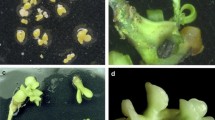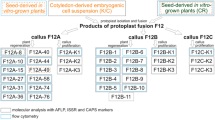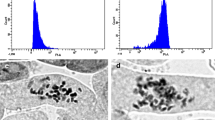Abstract
Somatic hybridization was performed via electrofusion between embryogenic suspension-derived protoplasts of transgenic green fluorescent protein (GFP) Satsuma mandarin (Citrus unshiu Marc. cv. Guoqing No. 1) (G1) callus and mesophyll protoplasts of calamondin (Citrus microcarpa Bunge), and three embryoids expressing GFP under UV light were obtained after 60 days of culture. The three embryoids were considered not as diploid cybrids but true allotetraploid somatic hybrids, as it was based on: (1) citrus heterokaryons are generally more vigorous and have higher capacity for embryogenesis as compared with unfused and homo-fused embryogenic callus protoplasts; (2) the callus line of G1 Satsuma mandarin has lost the embryogenesis capacity; and (3) citrus diploid cybrids produced by symmetric fusion always possess nuclear genome of mesophyll parent, and calamondin without GFP gene was used as leaf parent in this study. Subsequent flow cytometry, simple sequence repeat and cleaved amplified polymorphic sequence analysis of one regenerated callus mass and three resulting plants validated this supposition, i.e., the callus was derived from transgenic G1 callus protoplasts, and the three plants were true allotetraploid somatic hybrids possessing nuclear genomic DNA of both parents and cytoplasmic DNA from callus parent. The potential of transgenic GFP citrus callus as suspension parent in citrus somatic fusion to study the mechanism of cybrid formation, create new citrus cybrids, and transfer organelle-encoded agronomic traits was also discussed.





Similar content being viewed by others
Abbreviations
- CAPS:
-
Cleaved amplified polymorphic sequence
- cpDNA:
-
Chloroplast DNA
- G1:
-
Satsuma mandarin, Citrus unshiu Marc. cv. Guoqing No. 1
- SSR:
-
Simple sequence repeat
- mtDNA:
-
Mitochondrial DNA
- MT:
-
Murashige and Tucker (1969)
References
Al-Janabi SM, McClelland M, Petersen C, Sobral BWS (1994) Phylogenetic analysis of organellar DNA sequences in the Andropogoneae: Saccharinea. Theor Appl Genet 88:933–944
Cabasson C, Luro F, Ollitrault P, Grosser JW (2001) Non-random inheritance of mitochondrial genomes in Citrus hybrids produced by protoplast fusion. Plant Cell Rep 20:604–609
Cheng YJ, Guo WW, Deng XX (2003) Molecular characterization of cytoplasmic and nuclear genomes in phenotypically abnormal Valencia orange (Citrus sinensis) + Meiwa kumquat (Fortunella crassifolia) intergeneric somatic hybrids. Plant Cell Rep 21:445–451
Demesure B, Sodiz N, Petit RJ (1995) A set of universal primers for amplification of polymorphic noncoding regions of mitochondrial and chloroplast DNA in plants. Mol Ecol 4:129–131
Deng XX, Zhang WC (1995) Citrus protoplast culture and fusion. Prog Nat Sci 5:35–41
Fu CH, Guo WW, Liu JH, Deng XX (2003) Regeneration of Citrus sinensis (+) Clausena lansium intergeneric triploid and tetraploid somatic hybrids and their identification by molecular markers. In Vitro Cell Dev Biol Plant 39:360–364
Grosser JW, Gmitter FG Jr (1990) Protoplast fusion and citrus improvement. Plant Breeding Rev 8:339–374
Grosser JW, Gmiitter FG Jr (2005) Application of somatic hybridization and cybridization in crop improvement, with citrus as a model. In Vitro Cell Dev Biol Plant 41:220–225
Grosser JW, Gmitter FG Jr, Tusa N, Recupero GR, Cucinotta P (1996) Further evidence for a cybridization requirement for plant regeneration from citrus leaf protoplasts. Plant Cell Rep 15:672–676
Grosser JW, Ollitrault P, Olivares-Fuster O (2000) Somatic hybridization in Citrus: an effective tool to facilitate variety improvement. In Vitro Cell Dev Biol Plant 36:434–449
Guo WW, Grosser JW (2005) Somatic hybrid vigor in Citrus: direct evidence from protoplast fusion of an embryogenic callus line with a transgenic mesophyll parent expressing the GFP gene. Plant Sci 168:1541–1545
Guo WW, Deng XX, Shi YZ (1998) Optimization of protoplast electrofusion parameters and interspecific somatic hybrid regeneration in Citrus (in Chinese). Acta Bot Sin 40:417–424
Guo WW, Duan YX, Olivares-Fuster O, Wu ZC, Arias CR, Burns JK, Grosser JW (2005) Protoplast transformation and regeneration of transgenic Valencia sweet orange plants containing the juice quality related pectin methylesterase gene. Plant Cell Rep 24:482–486
Guo WW, Prasad D, Cheng YJ, Serrano P, Deng XX, Grosser JW (2004) Targeted cybridization in Citrus: transfer of Satsuma cytoplasm to seedy cultivars for potential seedlessness. Plant Cell Rep 22:752–758
Huo HQ, Hao YJ, Deng XX (1999) Induction of embryogenic callus of loose skin mandarins (in Chinese). Acta Biol Exp Sin 32:289–295
Kijas JMH, Thomas MR, Fowler JCS, Roose ML (1997) Integration of trinucleotide microsatellite into a linkage map of Citrus. Theor Appl Genet 94:701–708
Kumar A, Cocking EC (1987) Protoplast fusion: a novel approach to organelle genetics in higher plants. Am J Bot 74:1289–1303
Moreira CD, Chase CD, Gmitter FG Jr, Grosser JW (2000) Inheritance of organelle genomes in Citrus cybrids. Mol Breed 6:401–405
Moriguchi T, Hidaka T, Omura M, Motomura T, Akihama T (1996) Genotypes and parental combination influence efficiency of cybrid induction in Citrus by electrofusion. HortScience 31:275–278
Moriguchi T, Motomura T, Hidaka T, Akihama T, Omura M (1997) Analysis of mitochondrial genomes among Citrus plants produced by the interspecific somatic hybrids of ‘Seminole’. Plant Cell Rep 16:397–400
Murashige T, Tucker DPH (1969) Growth factor requirements of citrus tissue culture. In: Chapman HD (ed) Proc 1st Intl Citrus Symp, vol. 3. University of California Riverside, Riverside, pp. 1155–1161
Nicolosi E, Deng ZN, Gentile A, La Malfa S (2000) Citrus phylogeny and genetic origin of important species as investigated by molecular markers. Theor Appl Genet 100:1155–1166
Olivares-Fuster O, Pena L, Duran-Vila N, Navarro L (2002) Green fluorescent protein as a visual marker in somatic hybridization. Ann Bot 89:491–497
Saito W, Ohgawara T, Shimizu J, Kobayashi S (1993) Citrus cybrid regeneration following cell fusion between nucellar cells and mesophyll cells. Plant Sci 88:195–201
Takami K, Matsumaru A, Yahata M, Kunitake H, Komatsu H (2005) Utilization of intergeneric somatic hybrids as an index discriminating taxa in the genus Citrus and its related species. Sex Plant Reprod 18:21–28
Wu JH, Ferguson AR, Mooney PA (2005) Allotetraploid hybrids produced by protoplast fusion for seedless triploid Citrus breeding. Euphytica 141:229–235
Xu XY, Liu JH, Deng XX (2004) Production and characterization of intergeneric diploid cybrids derived from symmetric fusion between Microcitrus papuana Swingle and sour orange (Citrus aurantium). Euphytica 136:115–123
Yamamoto M, Kobayashi SA (1995) Cybrid plant produced by electrofusion between Citrus unshiu (Satsuma mandarin) and C. sinensis (sweet orange). Plant Tissue Cult Lett.12:131–137
Yamamoto M, Matsumoto R, Okudai N, Yamada Y (1997) Aborted anthers of Citrus result from gene-cytoplasmic male sterility. Sci Hort 70:9–14
Zhu YJ, Agbayani R, Moore PH (2004) Green fluorescent protein as a visual selection marker for papaya (Carica papaya L.) transformation. Plant Cell Rep 22:660–667
Acknowledgements
This research was financially supported by the National Natural Science Foundation of China (No. 30571288), the Ministry of Education of China (Nos. 705037, NCET-04-0734, and IRT0548), the Huoyingdong Education Foundation (91030), and the International Foundation for Science (IFS, D/2895-3).
Author information
Authors and Affiliations
Corresponding author
Rights and permissions
About this article
Cite this article
Cai, XD., Liu, X. & Guo, WW. GFP expression as an indicator of somatic hybrids between transgenic Satsuma mandarin and calamondin at embryoid stage. Plant Cell Tiss Organ Cult 87, 245–253 (2006). https://doi.org/10.1007/s11240-006-9158-3
Received:
Accepted:
Published:
Issue Date:
DOI: https://doi.org/10.1007/s11240-006-9158-3




